British legend of Balaclava: “thin red line” and the attack of the light brigade
At the same time, while the hussar brigade of Lieutenant-General Ryzhov was cut with the British dragoons, 1 Ural Cossack Regiment of Lieutenant Colonel Horoshkhin (about 600 riders) attacked Colin Campbell's 93 Scottish Infantry Regiment (650 forces), and 100 Scottish Infantry Regiment (XNUMX forces) attacked Colin Campbell (XNUMX soldiers). on the flanks).
The 93 Scottish Regiment lined up in front of the village of Kadikaya. The soldier was small, while it was necessary to occupy a wide front, so the commander of the Scottish Infantry Regiment 93 Baronet Colin Campbell ordered the soldiers to line up in a row of two, instead of the rank provided for in such cases by four. It is believed that Campbell told his soldiers: “Guys, there will be no order to retreat. You must die where you stand. ” His adjutant John Scott replied for everyone: “Yes, sir Colin. If necessary, we will do it. ” The soldiers were in red uniforms, and the Times correspondent, William Russell, later described the Scots as "a thin red strip bristling with steel." The expression "thin red line" or "red line" is included in history.
Scottish arrows repelled the Cossack attack. The 93 regiment fired three volleys, with 800, 500 and 350 yards, and the Cossack regiment withdrew. It must be said that the memories of the participants in the battle from the Russian side - Lieutenant-General I. Ryzhov, staff-captain E. Arbuzov, as well as studies of a number of Russian historians - cast doubt on the British version of events. The British had already successfully waged an information war, and even the failures and failures of the command were used for propaganda purposes. In particular, there is evidence that the Scottish regiment was attacked not by the Cossacks, but by the 4 squadron of the hussars of the Saxe-Weimar (Ingermanland) regiment. Their attack was repelled by choke fire and grape-shot.
"Thin red line." Painting by Robert Gibb
Attack light cavalry brigade
Cavalry fights continued. The British heavy brigade attacked our cavalry on Kadikioi heights, which stood motionless. General Ryzhov, crammed by the dragoon brigade, retreated. At the same time, Ryzhov intentionally passed between two redoubts (second and third) that were beaten off by the Turks in the morning, enticing the British to a dangerous position. Suddenly, Russian cannons struck Scarlett on the right and left. The English dragoons, having lost several dozen people killed and wounded, quickly retreated.
The French and British commanders Canrober and Raglan watched the battle. The British lord saw that the Russians had begun to pull the guns off the redoubts they had taken in the morning. Raglan told Kanrober that it is a pity to give the Russian guns. For Raglan, it was a shame - to give English weapons to the enemy. Kanrober, on the other hand, thought more sensibly and said: “Why go to the Russians themselves? Let them go on us: we are in an excellent position, we won’t get out of here! ”However, Raglan acted in his own way. Canrober did not have the authority of St. Arnaud and Raglan did not listen to him. The 1-i and 4-i British divisions have not yet approached, so the lord ordered the British cavalry commander, Count Lucan, to push the cavalry forward and take advantage of the opportunity to take heights. The cavalry was supposed to support the infantry, which was instructed to advance in two columns.
Russian troops were located in-depth "horseshoe". Its one end was located near Kadikioi near the redoubts taken in the morning, the second - at the foot of the Fedyukhiny Mountains. Lucan, realizing that such an attack poses a great threat, instead of following an order, confined himself to a demonstration. The commander of the cavalry ordered him to ride all his cavalry, moved the light brigade to the left some distance, and left the dragoon in place, waiting for the infantry. Count Lucan decided that he should wait for the approach and the advance of the infantry, and then support it with cavalry. Later, Raglan and Lucan will try to shift the blame for the defeat on each other. So, Lucan was accused of allegedly missing a convenient moment for an attack.
In order to encourage his cavalry commander to take more active actions, Raglan sent him a more specific order. Lord Raglan called the Chief of Staff of the British Army, General Airy, and instructed the cavalry "to advance to the front line, pursuing the enemy, and tried to prevent the enemy from carrying the weapons away." The adjutant of the Chief of Staff, Captain Nolan, handed the order to Lucan.
Lucan handed the order to the commander of the light brigade, Lord Cardigan, to launch an offensive. The brigade was supposed to strike at the valley between Fedyuhin heights and redoubts captured in the morning. James Cardigan tried to object, saying that "the Russians had a battery in the valley, against the front of the English cavalry, and other batteries and shooters on both flanks." Lucan said: "I know, but we have no choice but to fulfill the will of the commander in chief." The cardigan commanded: “Attack!” In the first line, the 13 light dragoon and 17 th Uhlan regiments came in the second - 11 th Hussars, in the third - 4 th light dragoons and 8 th Hussars. The heavy brigade, at which Lucan remained, was supposed to support the attack of the Cardigan Brigade.
The order in the regiments was brilliant, and the brigade commander Cardigan rode ahead. Russian artillery opened fire on the enemy cavalry. First they shot at the cores and grenades, then switched to the canister. Then the arrow-fittings, scattered on the slopes of the heights, connected to the shelling. One of the first to kill off was Captain Nolan, who was riding in the front line of the 17 Uhlansky regiment. A grenade from a Fedyukh heights exploded near him. A grenade splinter pierced the chest of a brave Englishman. When the Russian nuclei began to reach the heavy brigade, the cavalry commander Lucan was wounded in the leg, his adjutant and nephew, Captain Charteris, died. By order of Lucan, Scarlett’s heavy brigade stopped and then returned to her position in good order. As a result, the light brigade lacked the support of the dragoons.
Selected British cavalry suffered some losses from rifle artillery fire. But he did not stop the cavalry, but only angered the British, who dreamed of reaching the Russian guns and avenging their fallen comrades.
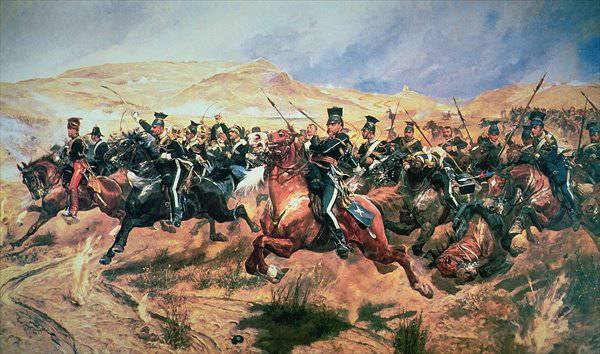
Attack light brigade. English artist Richard Keyton Woodville
As soon as the movement of enemy cavalry was discovered, the Odessa Chasseur Regiment withdrew to Redoubt number 2 and built up in a square. Therefore, the British cavalry attacked the Don battery, which was located across the valley. The Russian battery gave its last salvo with a canister at close range. But the furious British did not stop. General Cardigan was one of the first to burst onto the battery. The battery was covered by six hundred 1 of the Ural Cossack Regiment under the command of Lieutenant Colonel Horoshkhin. They stood only a few dozen steps. However, the Ural regiment that day proved to be not the best way. Cossacks overestimated the forces of the enemy, suddenly panicked and ran. Only a part of the Cossacks came to the aid of their comrades. A short but furious battle ended in favor of the British. The British seized two guns, and two more guns were rescued by Russian gunners. The Don battery was saved from total destruction by a counter-attack of the 53-th Don Cossack Regiment.
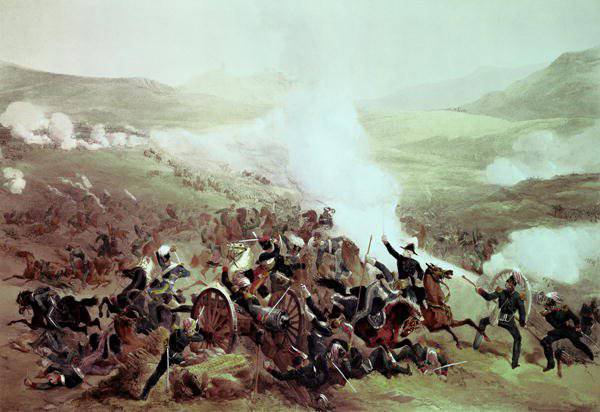
After that, the British brigade continued the offensive. Next stood the Ryzhov hussars, the Russian cavalry was ready for battle, but was instructed to retreat in order to lure the British under the crossfire of our batteries. The British began to pursue the Russian cavalry in the direction of Chorgun bridge. While the English cavalry, fascinated by the initial success, continued to pursue the Russian hussars, the Russian command was preparing to shut the trap. General Liprandi ordered Colonel Eropkin, commander of the Consolidated Uhlan Regiment (six ulan squadrons were standing at the redoubts number 2 and 3) to strike at the enemy.
When the English cavalry returned, the Russian lancers hit the enemy’s flank. Colonel Eropkin himself, surrounded by three English horsemen, killed one and knocked another off his horse. At the same time, British and infantry and artillery fired at the British (Russian cavalry suffered from its “friendly fire”, which was mistaken for the British). The officers of the English brigade in a few minutes was half killed and wounded. The light brigade was crushed. The Russian lancers pursued the remnants of the enemy brigade to the redoubt number 4. The battlefield was littered with corpses and wounded. This fight lasted only about 20 minutes, and during this time 365 people died and were captured. The British lost and almost 500 their horses. Therefore, the remnants of the brigade retreated significantly on foot.
Perhaps the English brigade would have been completely destroyed if African horse rangers of General d'Alonville did not come to the rescue. The French rangers attacked in two echelons: the first echelon under the command of divisional Abdell attacked the artillery of the Zhabokrit detachment standing on the Fedyuhin heights, and the second, under the command of d 'Alonville, hit the infantry covering the guns. In addition, the 4-I British division, led by General George Katkart and the Espinasse brigade, were directed against the Zhabokrit detachment. 1-I British division of George, Duke of Cambridge was sent to the redoubts, against the troops of Liprandi.
The first two squadrons of d'Alonville broke through the rifle chain covering the Zhabokrit artillery, and began to chop down the artillery servants. Two other squadrons rushed into the two battalions of cover. But General Zhabokritsky managed to build a soldier of the Vladimir regiment, and they met the enemy with friendly volleys. The French huntsmen, hit by well-aimed shots of the Reed (2 th Linear (Plastonic) Battalion of the Black Sea Cossack Army) and the shooters, went to Sapun-gore. Thus, although the French attack did not reach its goal, it weakened the fire of the Zhabokrit detachment, directed against the British light brigade. The plan of the attack of the Allied infantry, was canceled with the general consent of Raglan and Canrober.
A further battle was limited to the skirmish of parts of the Katkarta division, which went out to Redoubt No. 4 with the arrows of the Odessa regiment. The fight stopped at 16 hours. The Allied Command decided to confine itself to the defense of the inner ring of fortifications and not to storm the external redoubts. The reinforcements that came up were concentrated at Balaclava. General Liprandi was also content with the first success and did not begin to develop the offensive. Russian infantry occupied the line of redoubts. One battalion was in reserve at the Black River. Zhabokritsky detachment occupied Feduhin height. The cavalry was located behind the right flag of the detachment Liprandi.
Thus, the Russian troops established themselves on the left bank of the Black River. They occupied positions only two and a half kilometers from Balaclava. Liprandi was waiting for reinforcements and artillery to attack the enemy and take the city.
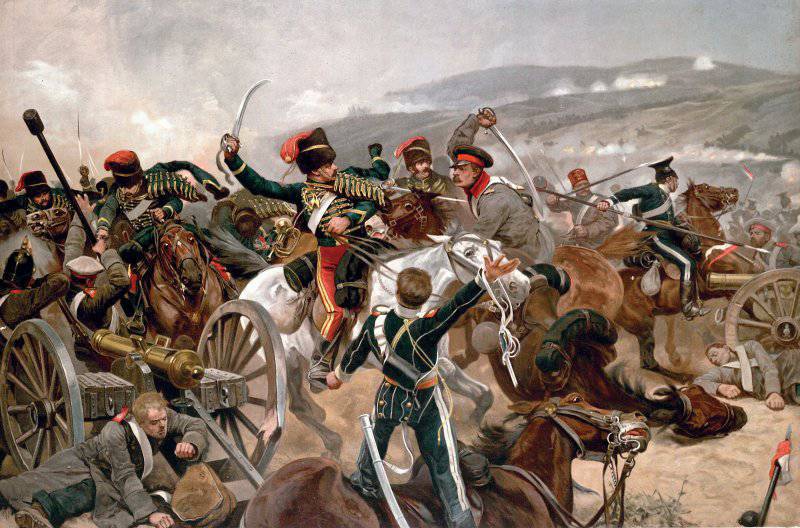
Paul Filippoto. Brigade attack led by General Allonville
Battle results
Russian troops lost about 600 people. The Allies reported the loss of 600 people. However, these figures are clearly underestimated. The Turks lost only 170 people while taking redoubts, and about 300 people were injured. It should be noted that the Turkish expeditionary corps, which had not previously shone, was completely demoralized during the Battle of Balaclava and, as an independent combat unit, did not represent anything more.
The reckless attack of the light cavalry brigade of Cardigan cost the British alone some three hundred people killed, and about 60 people were taken prisoner. Total British troops lost on this day only killed about 550 people. French losses were small - about 50 people. In total, the Allies lost about 1-1,5 thousand people. The Russian trophies became one banner, captured during the taking of the redoubt number 1, 11 guns, dozens of ammunition boxes, all Turkish property and entrenching tools.
The battle brought the benefit of the Russian army and tactical side. The Anglo-Turkish forces suffered sensitive damage and were forced to limit their range of actions, focusing on the defense of Balaclava. The battle strengthened the morale of the Russian army. The Russian army was convinced that it could withstand a strong enemy and felt the taste of victory. In Sevastopol and in the army, Menshikov talked a lot about the hundreds of dead British cavalrymen and about the trophies taken. Numerous cases were told that showed the highest courage that the Russian army fought on that day. Thus, the orderly of General Zhabokritsky, a Cossack and a constable of the Donskoy Regiment, three of them overturned the enemy horsemen who surrounded the general and rescued him.
Wounded soldiers massively refused to leave their positions. A private soldier of the Dnieper infantry regiment, Klim Efimov, took part in the capture of the village of Mosquitoes and was wounded by a grenade splinter in the face. But after dressing he asked the doctor to let him go to the company, where he stayed until the end of the battle. The regular 5 th jäger company, Dmitry Komissarov, had two fingers in his hand, but he didn’t want to leave the position. However, the gushing blood drenched the cartridges and made it difficult to charge the choke. As Liprandi noted in the report to Menshikov, Dmitry asked the officer to "shoot while from my choke" and went for a dressing. A few minutes later he returned from the dressing and continued to fire until the end of the battle. The ordinary 4 of the carabinier company, Tsvetkovsky, was seriously wounded in the leg and lay when the broken English cavalry rushed back. Tsvetkovsky, seeing an Englishman galloping on a magnificent horse, said: “Oh, priests, do not let him jump out! He was pushing nicely, even if he tried a Russian lead at the distance! ”The soldier knocked down the enemy with a good shot, and only then allowed him to carry it to the dressing.
There were a lot of such cases. Soldiers and officers in all wars and at all times showed the best qualities of the Russian people. General Liprandi noted that the whole army was eager to fight the enemy. “The whole battle can be called one heroic feat, and in general it is very difficult to give anyone a special advantage over the others. The competition was common both between each branch of the military and between all ranks in general, ”the general wrote.
The Allied command began to doubt the success of the siege of Sevastopol. The allies had to finally abandon plans for an immediate assault on Sevastopol and move on to a positional siege. The British had a feeling of defeat, and a painful one, aggravated by the awareness of senselessly ruined lives, losses caused by lack of talent and military ignorance of generals. Irritation and bewilderment caused not hundreds of dead people, in war it was common, and the frivolity of the command, which led to defeat.
Both sides noted the courage of the English light cavalry. However, it was rightly noted that the cardigan cavalry’s attack was unreasonable and doomed to attack. French General Pierre Bosquet summed up this episode of the battle: “It’s nice, but you can't fight like that.” Lord Raglan dumped all the blame on his subordinates. Allegedly, they did not understand his correct instructions. He said to Lord Cardigan, expressing his displeasure: “How could you attack the battery from the front, contrary to all military rules?” And Count Lukan said: “You destroyed the light brigade”. Command and the press took the side of Raglan, so as not to undermine the prestige of the army. Public opinion in England brought down a wave of criticism on two generals. As a result, General Lucan was forced to request the establishment of a commission to investigate his actions at the Battle of Balaclava.
In this case, do not forget about the mistakes of the Russian command. With more skillful actions, this relatively small battle could lead to more decisive results. Alexander Menshikov, not believing in the success of the cause near Sevastopol, did not attract more serious forces to the blow, which could put the Anglo-Turkish forces in Balaclava on the verge of death. They could be destroyed before the reinforcements arrived. After waiting for the 10 and 11 infantry divisions, the Russian commander could not arrange an attack of one detachment, which was not set decisive goals, but give the enemy a decisive battle, creating a decisive advantage in the Balaklava direction. The British, as the Battle of Balaclava showed, were not ready for the attack of the Russian troops and did not have time to strengthen their positions near Balaklava. The defeat of the British camp would put the British army in a very difficult position. Now the Allied command has determined its weak point and has taken measures to strengthen it.
The whole world thanks to this battle has received several great legends and popular winged expressions. The thin red line, the attack of the light cavalry brigade and Balaclava went down in history.
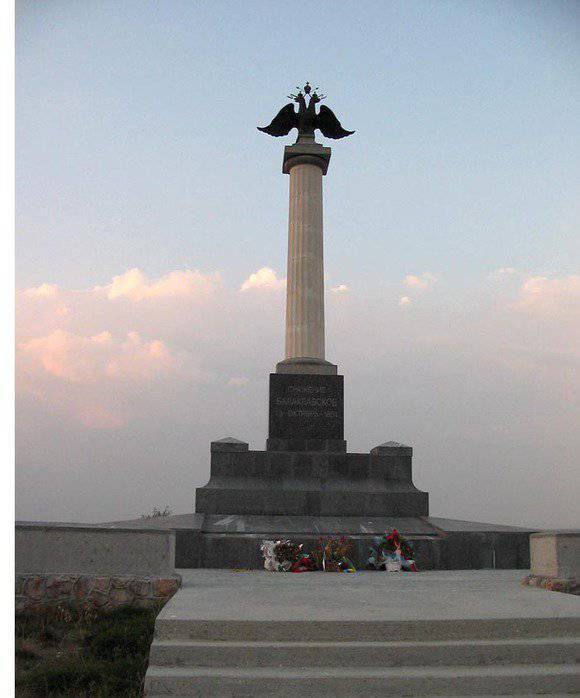
Monument to the Battle of Balaclava to the 50 anniversary of the Sevastopol defense at the height of Arab-Tabia (redoubt number 3)
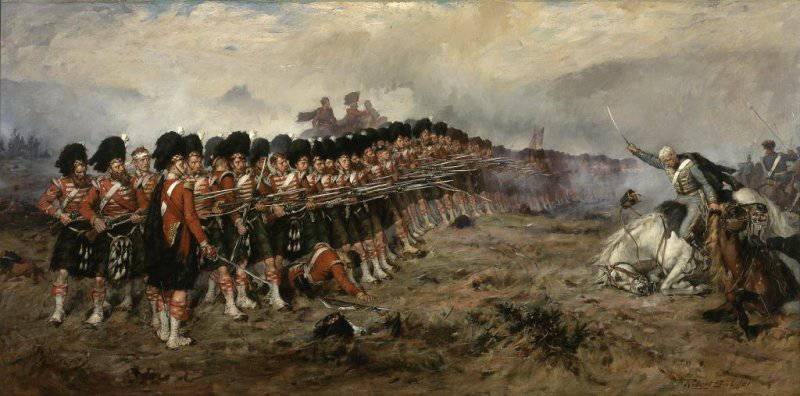
Information